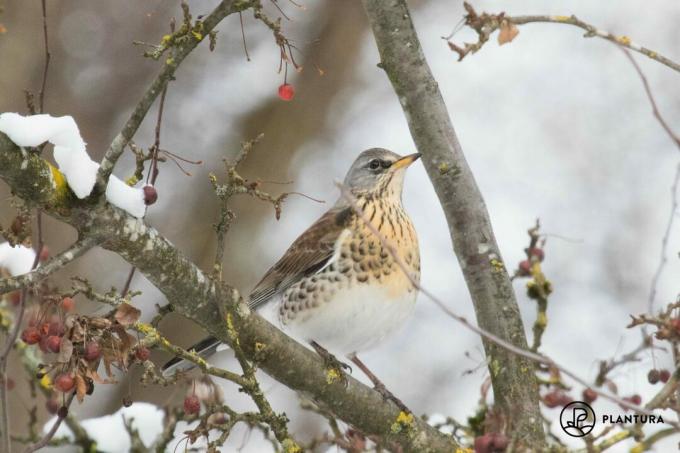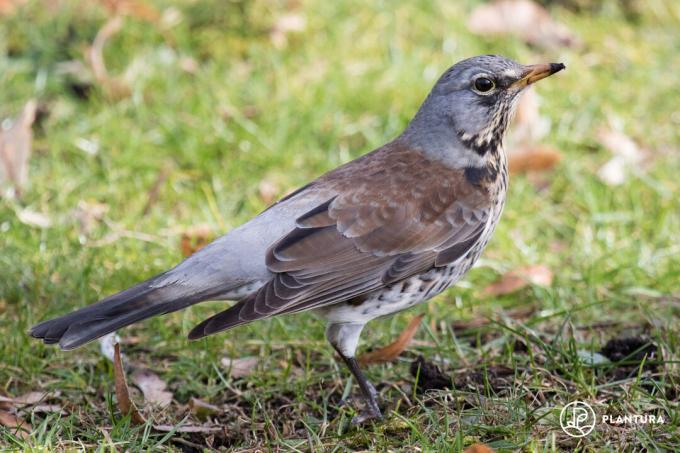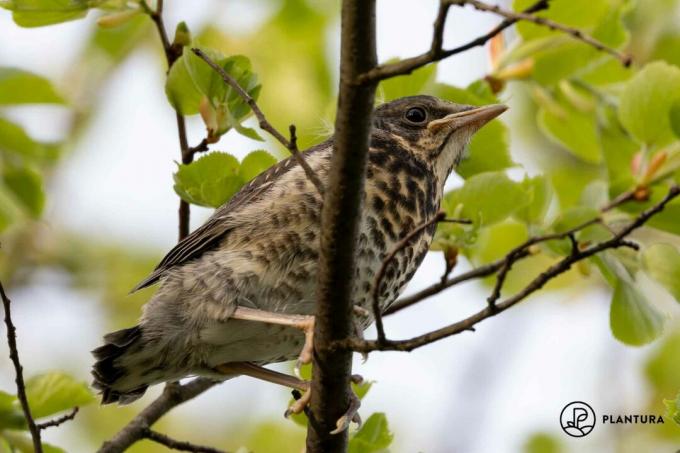What does the fieldfare look like? And what does she do in winter? We present the choke to you in our profile.

The Fieldfare (Turdus pilaris) has only established itself as a breeding bird in the last few decades. Before that, it was more at home in more northern parts of Europe. Today, however, they can be observed regularly in sparse forests and larger parks. And especially in winter, the fieldfare also searches for food in smaller gardens. During these cold months, the colorful thrush feeds on berries, fruit and fallen fruit. So its name is no coincidence, because the species has been associated with the juniper and its berries associated. Even their somewhat outdated name "Krammetsvogel" has this origin, because "Krammet" is just an old name for juniper. More exciting information about the fieldfare can be found in our profile below.
contents
- Fieldfare: wanted poster
-
How to recognize the fieldfare
- What does the song of the fieldfare sound like?
- What does the young fieldfare look like?
- How do you recognize bird eggs?
- Which habitat does the fieldfare prefer?
- Where can you find their nests?
- When does the fieldfare breed?
- What does the fieldfare do in winter?
-
This is how you can support fieldfares
- What do thrushes feed on?
- Which nest boxes are suitable for the fieldfare?
- How can you provide additional support for fieldfares?
Fieldfare: wanted poster
| size | About 25cm |
| Weight | About 120g |
| breeding season | March – June |
| lifespan | Up to 10 years |
| habitat | Semi-open landscapes, light forests, large parks and gardens |
| feed preference | Earthworms, snails, berries and other fruits |
| threats | Decline in food and natural habitat |
How to recognize the fieldfare
The fieldfare is similar in size and shape to its slightly better-known relative, the blackbird. The two species also share the yellow beak. However, there are no other similarities in appearance. Because in addition to the plain black blackbird the fieldfare is a true blaze of colour. Its grey-blue colored head is crossed by a light stripe over its eyes. The nape of the same color merges into a reddish-brown back and matching elytra. The lower back, also called the rump, is also grey-blue in color and ends in dark tail feathers. The light underside is traversed by black dots and the chest shines in a strong rusty yellow. Fieldfare males and females are difficult to tell apart visually.

What does the song of the fieldfare sound like?
The singing of the fieldfare cannot be compared to the melodic bird call of the blackbird measure up. It's more of a mix of gossip and teasing - with no real structure. Unlike the song, the fieldfare's call is much more distinctive and easy to identify. This sounds like a warning "check-tcheck-tcheck".
The song of the fieldfare sounds like this:

What does the young fieldfare look like?
Young fieldfares are easy to spot because they already look very similar to the adults. All the important features are already pronounced, even if the coloring is a little less intense than in the adult birds. In addition, the young birds are characterized by white spots on the elytra. After the first winter, the young thrushes lose their juvenile feathers and show off their adult plumage.

How do you recognize bird eggs?
The eggs of the fieldfare, which are about 3 centimeters in size, are similar to those of the closely related species blackbird. They have a blue-green base tone and are sprinkled with reddish-brown speckles. The female lays between five and seven eggs in a cup-shaped nest made of plant stems and leaves, lined with wet earth and padded with fine blades of grass.

Which habitat does the fieldfare prefer?
Fieldfares prefer semi-open habitats such as light forests, forest edges and groups of trees in the landscape. But they can also be observed in city parks and large gardens. Since the thrushes primarily forage in the ground, areas with low vegetation or open, moist soil are important when choosing a breeding site.
Where can you find their nests?
Even when fieldfares search for food close to the ground, they build their nests at a safe height in the forks of trees or tall shrubs. The breeding pairs can occur individually, but the thrushes often form colonies of up to 50 pairs. This community is particularly valuable in defending nests against predators. Cats, corvids and birds of prey are driven away loudly and with veritable flight attacks which the fieldfare use so-called "poo bombs" that make the attacker flee should.
When does the fieldfare breed?
The female lays her eggs between March and April and then incubates them for 10 to 13 days. The female takes care of the little nestlings for the first few days, after which both parents bring food regularly. After another 14 to 16 days, the young birds leave the nest and make their first attempts to fly. The parents support the young thrushes in their search for food for about another two weeks, but then the little ones are on their own. It is not uncommon for a second brood to follow the successful rearing of the first young.

What does the fieldfare do in winter?
Fieldfare are short-distance migrants, migrating in winter from northern parts of Europe towards central and southern Europe and the Mediterranean. In the past they were only found here as winter guests, but today they also breed in our latitudes. The pretty thrushes are quite sociable in the cold winter months and often come together in motley flocks staring or redwings. The birds go looking for food together and like to come into our gardens and help themselves to feeding stations.
This is how you can support fieldfares
If you want to transform your garden into a fieldfare paradise or just give the native birds a hand and want to support them in their daily struggle for food and nesting sites, here are some helpful tips and tricks.
What do thrushes feed on?
Fieldfares have a seasonally adjusted diet plan. In summer they feed mainly on earthworms and other small animals living on the ground such as snails. Later in the year they switch to fallen fruit, berries and other fruits. If you want to lay out additional food in the cold season, you should therefore stick to this nutrition plan. Many varieties of fruit – and apples in particular – are readily picked up from the ground by the fieldfare.

Which nest boxes are suitable for the fieldfare?
As free breeders, fieldfares prefer – as the name suggests – to build their nest outdoors. Therefore, closed nest boxes are not a good idea. These are more for cave breeders like blue tits or starlings suitable. If you want to try your luck, you should rely on so-called semi-hollow boxes, which have a large entry opening instead of just a small hole.
How can you provide additional support for fieldfares?
Since nest boxes are not the first choice to support fieldfares, one should focus more on creating natural nest sites. High hedges and well-branched trees are a must for any fieldfare nest. And those who do not have a sufficiently large garden for such structures can concentrate on the food supply. Because in addition to the additional feeding in winter, you can also provide enough food in summer, by leaving areas of low vegetation where the thrushes forage be able.
In addition, healthy soil life is important for the nutrition of the fieldfare, which satisfies the appetites of its offspring and its own primarily with earthworms. With our Plantura organic soil activator you can improve soil life in a sustainable and environmentally friendly way and thus lay a healthy foundation for your garden, your plants and our feathered friends.

Plantura organic soil activator
Effective long-term effect, good for the soil, harmless to humans, animals and nature
In addition to the fieldfare, the blackbird also has other patterned relatives that like to roam around in local gardens. the song thrush for example, has an even more heavily spotted underside than the fieldfare, but a rather plain upper side without blue-grey color elements. Get to know this garden bird and its many other characteristics in our species portrait.
...and receive concentrated plant knowledge and inspiration directly in your e-mail inbox every Sunday!

